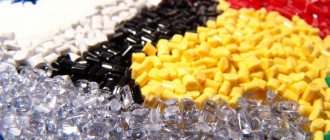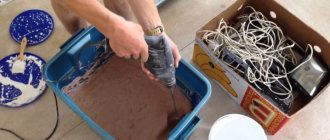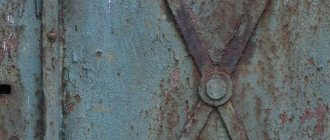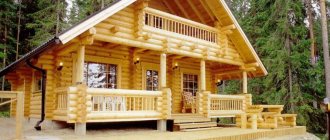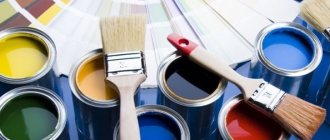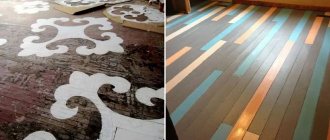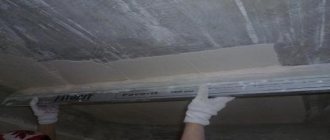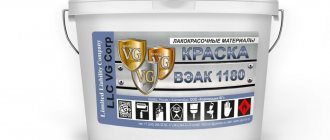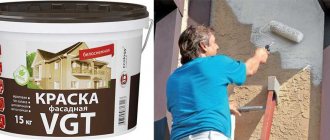What affects the mass of paintwork materials - factors
The weight of any substance in kg can be converted to volume in liters, and the calculation can also be done in the reverse way. Such knowledge is often needed by buyers of construction and finishing materials, which is why many are interested in what the mass of a certain can of paint is. It is not always possible to find information on the Internet or reference books, because paint and varnish materials are not the same in composition and are produced by different manufacturers. Difficulties may arise when purchasing a non-standard container, and then the calculations have to be done manually.
The weight of paint varies greatly depending on the type. There are a number of factors on which the mass will directly depend:
- specific gravity of the material;
- the presence of additional substances - additives, modifiers;
- density of the product.
Since all measurements are different, each paint weighs differently. There are GOSTs that set the limits for the mass of a particular paintwork material. Although many products are produced according to specifications, where the manufacturer independently determines this range.
How to count correctly
According to GOST, measurements are only allowed in kg/m3. Accordingly, this value is not suitable for a solution; its volume is measured in liters, which means that a mass in kg/l is needed. This figure will be a thousand times less than the approved one.
Expert opinion
Zakharova Irina Yurievna
Cleaning professional with 15 years of experience. Our best expert.
Ask a Question
To correctly calculate the weight, you need to obtain initial data, which is individual for each type of coating. Next, a two-component formula is used.
Once you know how much a can of paint weighs, you can determine the total amount of dye you need. If information is obtained on the mass and volume of the solution, this will allow a more detailed calculation of the flow rate. This approach can help save money.
See also
Features and color palette of metallic paints and how to apply them correctly
Necessary source data for translation
In addition to the fact that the type of product influences the calculation results, the manufacturer is also of great importance. To make the calculation yourself, you need the following initial data:
- specific gravity is an indicator of how much heavier a substance is than water of the same volume at a temperature of 4 degrees;
- additional substances in the composition - additives, modifiers;
- paint density.
The necessary data can be found on the manufacturer's packaging.
Calculation formulas and size of error
The least labor-intensive way to calculate how much 1 liter of paint weighs is to take the formula from a physics course. It is known that density can be calculated by knowing volume and mass. To get the mass, accordingly, you need to transform the formula. The original version looks like this: p = m/V. In this formula:
- p – density;
- m – mass;
- V – volume.
As a rule, in such substances the density is in the range from 1.2 to 1.6. This information is indicated on the jar of liquid.
Now you need to remember the mathematics and redo the formula so that the desired mass becomes the desired one. It will look like this: m = V*p. This formula is easy to understand and makes it possible to quickly find out the weight of the can. The density of paint is an order of magnitude higher than that of water-based liquids. This suggests that the mass of a liter jar will always be more than 1 kg.
Since not all data may be known in home calculations, the calculation may not be 100% accurate. As a rule, the percentage of error does not exceed 5. If painting is planned for domestic purposes, then this is not critical. For those who value accuracy, it is better to use specialized equipment. It also produces a figure with an error, but much less; even with delicate, meticulous work it will not be felt.
Example
Using an example, we can look at how to calculate how much a solution weighs. The first thing you need to do is find the density on the can. It can be indicated in kg/m3 or kg/l. In the example, we will consider a can of coating with a volume of 1 liter and a density of 1.4 kg/l. It turns out that to calculate the weight, you need 1l * 1.4kg/l = 1.4kg.
See also
How to dye a down jacket a different color at home
Sometimes you may need to calculate on the contrary - a displacement that contains 1 kilogram of coating. To do this you need: 1kg/1.4kg/l = 0.714l. To determine how many liters a kilogram of various dyes will contain, provided that the container volume is more than a liter, you need to use multiplication.
It is important to remember that for each coverage a separate calculation is required, taking into account the characteristics of a particular bank.
Calculation of paint weight
To find out how much weight there is in a liter of material, you will have to take a physics course. There is a density formula that takes into account volume and mass:
p=m/V
Here m represents mass, V is volume, p is density. Typically the density does not exceed 1.2-1.6. It is always indicated on the packaging of the paint and varnish material in the “technical characteristics” section. By converting the formula to m = V x p, taking the density and volume indicators (1 liter or other figure), you can easily calculate how many kilograms this jar weighs.
Since the density of paint is always greater than that of water-based liquids, the weight of a standard can will be higher than 1 kg - usually 1.08-1.44 kg. You can then use this information to determine the overall severity of the required dye.
How many kilograms are in a liter of paint?
Mass is a characteristic of a body, which is a measure of gravitational interaction with other bodies.
Volume is a quantitative characteristic of the space occupied by a body, structure or substance.
Density is a physical quantity defined as the ratio of body mass to body volume.
The relationship between liters and kilograms of paint is determined by a simple mathematical formula:
V—volume; m—mass; p—density.
In the calculation, the paint density was taken = 1300 kg/m3.
The density of paint can vary depending on temperature and pressure. You can find the exact value of paint density in reference books.
See also the universal program for converting liters to kg for any substance depending on its density.
If you need to convert m3 to tons, then see the program for converting tons to m3.
If you need to convert kg to m3, then see the program for converting kg to m3.
Question: How many kg are in a liter of paint?
Answer: 1 kg of paint is equal to 0.769 liters.
Question: How many liters are in a kilogram of paint?
Answer: 1 liter of paint is equal to 1.3 kilograms (kg).
You can quickly solve this simple mathematical operation using our online program. To do this, enter the initial value in the appropriate field and click the button.
This page presents the simplest program for converting kilograms of paint to liters. With this online calculator you can convert liters of paint to kg and back in one click.
The density of paint and varnish materials (paint and varnish materials) for walls, floors, and ceilings is much higher than this water indicator. That is why a kilogram jar may be smaller in appearance than a similar package of aqueous solutions. How to find out how much 1 liter of paint weighs? Such data may be required when planning repairs and calculating the cost of materials. There are special formulas for calculus.
Weight of different compounds
It should be remembered that the measurements taken may be inaccurate, because sometimes the density varies by a fraction of a percent. But the error rarely exceeds 5%, which is insignificant for domestic purposes. Laboratories that require precise calculations carry out their density measurements using special equipment. This allows you to obtain results with virtually no error.
Below is a table of the densities of individual types of paints. The limits of permissible values are indicated, which vary from one manufacturer to another:
| Type of paint | Density, kg/m3 |
| Water-based | 1,34-1,36 |
| Latex | 1,5-1,58 |
| Pentaphthalic enamels | 0,9-0,92 |
| Acrylic | 1,45-1,55 |
| Primer GF | 1,49-1,52 |
| Silicone | 1,39-1,4 |
Calculating the weight of paint can provide useful information. To carry out the calculations, you just need to read the attached data or find them on the manufacturer’s website.
Paint marking using a code
Some manufacturers encrypt types of paints, the type of base, operating conditions and special characteristics using letters and numbers. Such symbols can be divided into 5 groups: 1. Type of paint.
Letter abbreviations are used:
- B
– without volatile solvent - B
– water-borne - VD
– water dispersion - OD
– oranodispersive - P
– powder
2. Type of paint base
Indicated by two capital letters, for example AU (alkyd-urethane), PU (polyurethane), FL (phenolic), AK (polyacrylate), BT (bitumen), NC (nitrocellulose).
3. Paint operating conditions
Indicated by numbers:
- 1
– for external use - 2
– for interior decoration - 3
– conservation, protective - 4
– waterproof - 5
– special - 6
– oil and petrol resistant - 7
– chemically resistant - 8
– heat-resistant - 9
– electrical insulating
4. Material serial number of 1, 2 or 3 digits
5. Paint features
Indicated by letter code:
- HS
– hot drying
- HS
– cold drying
- PM
– semi-matte
- M
– matte
- PG
– low-flammability paint
- N
– paint with filler
- IN
– high viscosity paint
For example, the code for Dekor Acryl paint VD-AK-111 means:
VD – water-dispersed paint; AK – polyacrylate base; 1 – for external use; 11 – material number, has no meaning for the end user. The paint code PF-211 indicates a pentaphthalic base (abbreviation PF) and indoor use only (number 2).
Characteristics
So, what is the difference between different facade paints?
Density
This is a neutral characteristic by which only the viscosity of the paint and the content of binders and pigments can be assessed to a first approximation. As always, there is a catch. More precisely, two:
- Many manufacturers of cheap paints add fillers to them - neutral substances that increase volume and weight. You get more paint; however, neither the strength of the paint layer nor the hiding power of the paint increases.
- Excessive paint thickness only leads to uneven layers. Streaks appear on vertical surfaces.
Note:
The normal thickness for any water-based paint is the consistency of fat milk. Two thin layers dry faster and look much better than one thick one. Most manufacturers recommend diluting the paint by about 10 percent with water before use.
However, if the density of the paint differs little from the density of water, you can be sure that this is low quality paint. The norm is 1.4 - 1.5 kg/1000 cm3.
Solvent type
This characteristic determines what can be used to dilute the paint or dissolve a stain placed in the wrong place - water, white spirit, acetone, or some other solvent. Most facade paints are water-based and are diluted with water. But you won’t be able to wash off dried paint. It can only be removed mechanically - with a spatula or grinding.
Vapor permeability
One of the basic rules of construction: the vapor permeability of the wall should increase from the inside to the outside . Accordingly, high vapor permeability is an obvious advantage for facade paint.
The reason for the destruction of the wall is the low vapor permeability of the outer layer of plaster.
As a result, moisture accumulates in the wall. Vapor permeability can be expressed in numbers. Manufacturers do this in different ways:
- Sometimes the mass of water vapor that can pass through a square meter of wall in 24 hours is indicated. A good value is 130 grams/m2/24 hours.
- Some manufacturers indicate the SD coefficient. The smaller it is, the more vapor-permeable the paint. The best paint samples have an SD of 0.11 - 0.05. For comparison: a very good façade structural paint, Ceresit CT40, has an SD parameter of 0.3. However, it is applied in a thick layer. A thin layer of Ceresit CT42 has twice the vapor permeability.
- The diffuse resistance coefficient µ means essentially the same thing. An excellent value for µ is considered to be 1400-1500.
Abrasion resistance
Obviously, the higher it is, the stronger the paint layer. Durability is indicated in cleaning cycles. Excellent value - 5000 cycles; This is precisely the declared durability that we see in the above-mentioned acrylic facade paint Ceresit CT42.
Gloss level
In essence, this parameter only means whether the paint in front of us is matte or glossy. Matte is preferable because it masks minor surface defects. Gloss, on the contrary, emphasizes them.
Paint consumption
When technical specifications for façade acrylic paint are indicated, confusion always arises with this parameter. It is due to the fact that different manufacturers often understand quite different things by paint consumption:
- Most often, the consumption of the amount of paint is indicated in grams or milliliters for applying one thin layer to the prepared surface.
- Sometimes the parameter is confused with the hiding power of the paint: the amount of paint required for continuous, uniform painting of a surface of one square meter is indicated. Which means applying at least two layers.
Trying to paint a base in a contrasting color in one coat is a hopeless task. You will only achieve the appearance of untidy sagging.
- Another common option is to indicate the area that can be painted with one liter of paint.
If we take into account that the consumption of facade paint strongly depends on the surface of the facade and can vary significantly depending on its condition, confusion is inevitable.
Note:
a primer of comparable quality costs several times less than façade paint and greatly reduces its consumption on porous surfaces. The façade is always primed before painting.
Typical primer paint consumption per coat is 150-250 milliliters per square meter.
Additional Information
In addition to the above, the paint characteristics on the packaging often indicate:
- Drying time for one layer in hours.
- The degree of adhesion to different surfaces in megapascals.
- Moisture resistance to a static layer of water covering the paint, in hours.
- The presence or absence of antiseptic additives.
- Minimum and maximum temperatures for painting work.
Some more information and recommendations from the manufacturer.
Main types of paints and their characteristics
In fact, the issue of quality becomes more pressing the larger the volume of paint needed and the higher the requirements for coating. Often, unscrupulous manufacturers produce formulations that deviate from the norms, which naturally affects the quality of the product. Therefore, you should know the basic properties of high-quality paint.
Oil formulations
Compositions based on natural drying oil take a very long time to dry
Just a few decades ago there was simply no alternative to this option. This type of finishing product (as in the photo above) was used everywhere, despite its shortcomings. The basic requirements that all solutions must meet are set out in GOST 8292-85 “Thickly grated colored oil paints. Technical specifications" .
The main properties of this group of solutions are as follows:
- The products are made on the basis of natural drying oil with the addition of various pigments.
- The color range of oil compositions is quite narrow and averages about 10 colors, which does not allow the implementation of interesting color solutions.
- One layer after application dries for at least 12 hours, the recommended time is 24 hours, and at low temperatures the period can increase to three days.
Important! When working, good ventilation is necessary, as the composition releases substances that are undesirable for inhalation. It is important to use protective equipment - a respirator and goggles.
Currently, these compositions are most often used for finishing already painted surfaces, since other solutions do not apply to oil paint.
The density of oil paint should be 0.93-0-95 kg per 1 liter.
Alkyd products
The most famous line of compositions is PF-115 enamel
This group of products is very popular when doing DIY work due to the fairly simple application process and excellent coating properties. Such compositions are made based on synthetic solvents. All serious manufacturers produce such paints in accordance with GOST 6465-76 standards .
This group of products has the following characteristics:
- Drying time at normal humidity and ambient temperature of about 20 degrees should be about 6 hours.
- The surface is resistant to moisture and reliably protects the surface from adverse influences.
- Due to the presence of many pigments, the compositions can be of almost any color. It is worth noting that the colors of alkyd compositions are very rich and bright.
- When working, it is necessary to use protective equipment and ventilate the room: before drying, the coating releases some substances. Afterwards it is completely safe for human health.
- The resulting protective layer serves well both indoors and outdoors, although exposure to the sun may cause the coating to crack over time.
- Density according to regulatory documentation should be 0.90-0.92 kg per 1 liter.
Water-based compositions
A certificate is an indicator of the quality of a product of any water-dispersion paint.
This group of compounds is very popular due to a number of advantages, the main one being price. All products must comply with GOST 28186-89 “Water-dispersion paints. Technical specifications" .
Among the properties inherent in high-quality samples, the following can be distinguished:
Important! The paint is based on water, which makes it practically odorless and does not emit harmful substances. In addition, the solution can be easily diluted with water and can be easily washed off hands and tools.
- The paint can be supplied in a wide range of colors or in a base color, then any shade can be created independently using a special colorant, which significantly expands the design possibilities.
- The compositions have excellent adhesion to a wide variety of surfaces; it is important to choose the right option.
- The density of high quality water-based paint should vary from 1.34 to 1.36 kg per 1 liter.
Acrylic based solutions
Acrylic is a high-strength polymer that allows you to create reliable compositions
If you are faced with the task of qualitatively and reliably finishing a façade or walls in rooms with high humidity, acrylic paint will be an excellent option. The coating is durable, resistant to damage and moisture, while the layer is vapor-permeable, which allows moisture to freely escape from the structure. The composition must comply with the requirements of GOST 28196-89 .
This group has the following characteristics:
- Acrylic coating allows you to create a waterproof layer that can be washed using non-aggressive detergents. In this case, excess moisture leaves the base without hindrance.
- The high resistance of paints to ultraviolet radiation makes this option an excellent solution for facades and other walls located in the open air.
- The service life is the longest of all the options considered.
- The optimal density of acrylic paint is from 1.45 to 1.55 kg per 1 liter.
GF primers
Glypthal primers are a very versatile product.
Although these compositions do not apply to paints, their choice directly affects the quality of the final coating, so we will consider their properties:
- The compositions must comply with the standards of GOST 25129-82.
- Their scope of application is wide - from metal to wood.
- Treatment not only improves adhesion, but also serves as an additional protective barrier against adverse factors.
- The density of glyphthalic primers should be in the range of 1.49-1.52 kg per 1 liter.
Having decided on the question of what paint to paint the walls or ceiling, you can go to the store for water-dispersed paint. Here, however, the first problem awaits us. Unfortunately, in the conditions of the modern market and the lack of clear regulation, each manufacturer is free to indicate in the annotations those concepts and terms that it considers necessary. After comparing the labels of different brands, you feel somewhat confused by the variety of terms and definitions used.
To select paint for a specific type of surface, we will try to decipher and summarize the information indicated by the manufacturer on the labels.
| ATTENTION! All materials presented on the site belong to the site mastertim.ru and are written for people. Full or partial copying of text and (or) images, posting on other sites, use for personal gain is PROHIBITED! |
Studying the label on a can of paint
The most important values and characteristics for the consumer are:
- enamel color;
- degree of gloss;
- wear resistance;
- thixotropy;
- hiding power;
- paint consumption;
- enamel density;
- dry residue.
The color
of the enamel
largely depends on whether the paint is a ready-made color or whether it is intended for further tinting. Ready-made white paint has increased whiteness and, as a rule, cannot be tinted. Thus, ready-to-use paints are identified by the manufacturer by color: white, dazzling white, orange, sea wave, lilac, etc.
Paints for tinting are designated more complexly:
| W0, A | white paints (bases) can be used ready-made or tinted |
| TR, C, CLR, FGL, W2 | transparent and translucent bases exclusively for tinting |
Tinting paints are usually more expensive than ready-made paints, since high-quality raw materials are used for their production and the requirements for consistency of composition are more stringent.
Gloss level
colors are graded from completely matte to completely glossy:
| CM or 0-5 | completely matte (super matte) |
| M or 6-10 | matte |
| PM or 11-29 | semi-matte |
| PG or 30-59 | semi-gloss |
| G or 60-89 | glossy |
| SG or 90-100 | completely glossy (super glossy) |
Glossy paints are good for perfectly smooth surfaces without defects. As the gloss level increases, the wear resistance of paints increases. Matte paints are more tolerant of surface defects.
Wear resistance or resistance class
is crucial when determining what paint to paint a particular room. Typically, wear resistance is characterized by the manufacturer in the number of dry cycles (for non-moisture-resistant or wet abrasion (for moisture-resistant paints). The number of cycles is usually overestimated by 5-10 times. For example, for 1000 specified cycles, the real value may be 100-200 cycles. For the ceiling in the living room this is more than enough. And in the kitchen or bathroom, a good housewife will achieve this amount of wiping, for example the walls near the sink, in 2-3 years.
On many labels, wear resistance is indicated in classes or types, which is more convenient and reliable:
| class 1 (type E1) – ultra-resistant to washing | Bathrooms, bathrooms, dining rooms, kitchens |
| class 2 (type E2) – wash-resistant | Ceilings and walls requiring periodic maintenance |
| class 3 (type E3) – resistant to washing off (wiping) | Ceilings and walls requiring periodic maintenance |
| class 4 (type E4) – resistant only to dry abrasion | Ceilings and walls that do not require further maintenance |
| class 5 (type E5) - not resistant to any abrasion | Ceilings and walls that do not require further maintenance |
Thixotropy
(from the Greek thixis - touch and trop; - rotation, change), the ability of dispersed systems to restore the original structure destroyed by mechanical action. By this term, manufacturers characterize the ability of paint to increase its viscosity at rest and increase its ductility under mechanical stress. Thixotropy of paint is especially important when painting vertical surfaces, as it will avoid smudges. For ceilings, you can use non-thixotropic paint.
Covering power
is one of the most important indicators and is characterized as the ability of a paint and varnish material, when uniformly applied to a surface, to make the color of the latter invisible. Covering power is measured in grams of dry film per m2 of non-absorbent, contrasting surface (g/m2). There is also a gradation of hiding power in classes: so class 1 means one layer of paint is sufficient, class 2 means painting in two layers, etc. Many manufacturers prefer to indicate paint consumption per m2 and the total number of layers instead of hiding power.
Paint consumption
is determined in the amount of liquid paint required to cover 1 m2 of surface. We need this indicator to calculate the required number of layers and the total amount of paint. Depending on the type of surface, paint consumption may vary within certain limits.
According to Russian standards, paint consumption is expressed in kg/m2. According to European standards in m2/liter.
Density
enamel indicated by the manufacturer on the label is the weight of a liter of paint. This value allows you to convert between liters and kilograms. Multiplying the density by the volume we get the mass (the weight of the paint). Accordingly, dividing the mass by the density, we obtain the volume of paint.
For water-dispersion paints, the density varies from 1.2 to 1.5 kg/liter.
As the density (read “weight”) of paint increases, the likelihood of an increase in the proportion of solid fillers (chalk, lime, marble) in relation to polymer binders increases. In addition, paints with high density have increased consumption and low ductility.
Dry residue
(or
non-volatile matter fraction
) reflects the amount of pigments and binders in paints and varnishes and reflects the percentage of water or solvent content. Dry residue is sometimes indicated by weight and volume. The higher the solids, the better. For interior paints, the average value is 45-65%.
| ATTENTION! All materials presented on the site belong to the site mastertim.ru and are written for people. Full or partial copying of text and (or) images, posting on other sites, use for personal gain is PROHIBITED! |
How to calculate paint consumption and number of layers
How much paint will be needed to cover the surface?
Most manufacturers indicate paint consumption (per layer) and the number of layers based on the basic types of surfaces (wood, concrete, plaster, etc.). In this case, hiding power is equal to the paint consumption per layer multiplied by the number of layers.
If the hiding power is known, then knowing the dry residue you can independently calculate the approximate paint consumption using the formula:
(Having power/Dry residue)*100
For example, you need to paint a ceiling with an area of 12 m2:
Paint coverage - 120g/m2
Dry paint residue - 60%
Paint consumption per m2 is: 120/60*100 = 200 g/m2
The total paint consumption is: 200*12 = 2.4 kg.
Paint consumption for a single-layer coating is: 200/2 = 100 g/m2 (+/- 20% depending on the surface).
Read previous articles:
Choosing paint for walls and ceilings - what paint is made of, advantages and disadvantages of water-dispersed paints, part 1
DIY ceiling and wall painting
